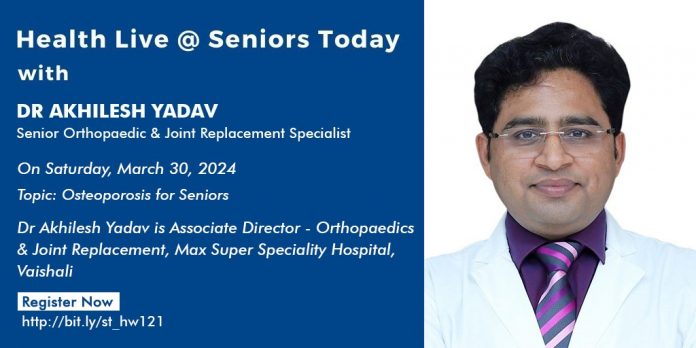On 30 March 2024, Seniors Today hosted their weekly Health Live Webinar with Dr Akhilesh Yadav, Senior Orthopaedic and Joint Replacement Specialist, who spoke on and answered questions about Osteoporosis for Seniors.
About Dr Akhilesh Yadav
Dr Akhilesh Yadav is Associate Director – Orthopaedics & Joint Replacement, Max Super Speciality Hospital, Vaishali. He has vast experience in the field of orthopaedics.
He did his MBBS from BRD Medical College, Gorakhpur (2002) followed by M.S (Orthopaedics) – MLB Medical College, Jhansi (2005) and MCH (Orthopaedics) – University of Dundee, United Kingdom (2010).
He has been the Director of Department of Orthopaedics at Healing Tree Hospital, Ghaziabad. He has also worked as Joint Replacement and Arthroscopic Surgeon at Pushpanjali Crosslay Hospital, Vaishali, Clinical Associate in the Department of Orthopaedics at Fortis Hospital, Noida. He has done his fellowship in joint replacement surgery from Asklepios Orthopaedic Clinic, Germany, fellowship in joint replacement surgery from University Klinikum, Mannheim, Germany, fellowship in joint replacement surgery from Hospital for special surgery, New York and fellowship in joint replacement from Lilavati Hospital, Mumbai. He is an esteemed member of some prestigious societies-
- Life Member of Indian Orthopaedic Association
- Life Member of Indian Arthroscopy Society
- Life Member of Indian Arthroplasty Association
His specialist interests include Joint Replacement Surgery and Arthroscopy.
Osteoporosis- osteo stands for bone and porosis means porous- ie when the bone becomes porous. Osteoporosis usually affects adults over the age of 30 years. In the Indian population, it mostly involves the elderly people.
The census of 2021 says that the Indian population over the age of 60 years constitutes about 8.6% of the total population.
Osteoporosis is a prevalent disease which means that 1 of every 2 people may suffer from osteopenia (the beginning of the weakening of the bone) and 1 out of every 5 people suffer from osteoporosis, in India.
It is more common in females (post menopausal) than males.
Post menopause, it affects 1 in every 3 females.
Osteoporosis is an age related and mutational disease which means that it sets in with age leading to loss of bone material leading to porous bones. Till the age of 30, there is a balance between the rate of bone formation resorption. However, after the age of 30 the catabolic process which is the degradation of the bone is more than the formation of the bones. This initially leads to osteopenia and if not diagnosed and treated on time, can then further lead to osteoporosis.
Signs and symptoms of osteoporosis:
- Pain in the bone is the most common symptom of osteoporosis.
- Pain in the muscles
- Spontaneous fractures: most commonly affected bones and areas are the spine, hip and pelvis
- Easy fatigability
Diagnosis is made by consulting with your orthopaedic surgeon on developing any of the above symptoms. He/ she will examine, evaluate and prescribe a few investigations, if deemed necessary.
These investigations include:
- Bone marrow density: this can be tested with the help of a BMD machine. This is a preliminary test which is qualitative in nature and not quantitative, thus will not be able to tell the staging/ grade of osteoporosis.
- Dexa scan- best investigation for diagnosis of osteoporosis. The WHO has recommended the following T score to help differentiate and diagnose between normal bone density, osteopenia and osteoporosis.
T score less than -2.5: Osteoporosis
T score between -0.1 to 2.5: Osteopenia
T score more than -0.1: Normal bone density
- Blood investigations to determine the levels of Serum Calcium, Vitamin D3, Vitamin B12, Vitamin C, vitamin K.
- Alkaline phosphatase levels
Few things that you can do to prevent osteoporosis
- Weight and reduction
- Active lifestyle
- Regular exercise
- Maintain a healthy and nutritional balance. Consume good amounts of foods which supplement calcium, Vitamin D, Vitamin B12, Vitamin K and protein
Management modalities for patients suffering from osteoporosis include:
- Oral medications for supplementation
- Advising the patient appropriate lifestyle modifications
- Anti catabolic medication- medicines that help prevent bone loss
- Injectables- these can be either 6 monthly or yearly basis. There are also injectables to help in bone formation which are given on a daily basis
- Avoid activities with a high risk of fall








